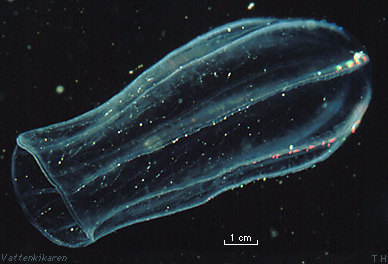 |
| A modern day comb jelly displaying bilateral symmetry |
 |
| A fossil of Eoandromeda octobrachiata |
Comb jellies have round or melon shaped bodies with pulsating lines of iridescent paddles on their flanks. The classic model of early animal evolution dictates that sponges came first, followed by jellyfish and sea anemones, and finally the comb jellies. 'Eoandromeda puts a little piece of weight in favour of a more basal position for comb jellies,' says Stefan Bengtson, a palaeontologist at the Swedish Museum of Natural History and a co-author on the paper.
The seed for this idea comes from the creature's morphology. It has octoradial symmetry, meaning its body can be sliced into eight identical pieces. This is in stark contrast to modern comb jellies, which, like humans, flies and sea anemones, have bilateral symmetry meaning that their body plan can be sliced into two identical pieces only. If comb jellies really evolved after the first creatures with bilateral symmetry, it would mean that this fundamental feature of most creatures today evolved twice in the Earth's history.
 |
| A simplified evolutionary tree (cladogram) which displays the original and proposed placements of comb jellies in early animal evolution |
Sponges are the simplest form of animal, possessing no form of symmetry and therefore would have to have evolved first.
By studying the genome of modern comb jellies, the team also have genetic evidence to back up this theory. 'It's great to have concordance between what these guys see in the fossil record and what's coming out of the genome,' says Andy Baxevanis, a genomicist at the National Human Genome Research Institute in Bethesda, Maryland. His team recently sequenced the genome of the comb jelly Mnemiopsis leidyi, and are now comparing it to sequences from sponges, jellies and corals (properly called cnidarians), worms and other animals to sort out which lineages came first.
So far, he says, the results suggest that sponges and comb jellies appeared before cnidarians. While some believe that the fossil is actually of a giant unicellular organism (such creatures have been discovered in the fossil record and in the oceans today), the evidence is strong and its ancient date of 580 million years does allow for some debate. It is discoveries like these which could be considered the most important as they simplify the tree of life and potentially solve long running debates on how the sheer diversity of life evolved.